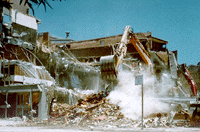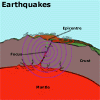 Suddenly the ground beneath your feet begins to move, trees and poles
begin to sway, another thud moves under your feet and the buildings near
you start to shake and move. Earthquake!
Suddenly the ground beneath your feet begins to move, trees and poles
begin to sway, another thud moves under your feet and the buildings near
you start to shake and move. Earthquake!
Anyone who has experienced even a small tremor knows that the above description cannot hope to describe the feeling when the solid dependable Earth suddenly starts to move and fall apart. Fortunately, large Earthquakes are rare in Australia, but as was discovered in Newcastle, New South Wales, on 28th December 1989, they do not have to be large to be devastating.
Characteristics of earthquakes
Earthquakes occur when energy stored deep in the rock of the Earth's crust
is suddenly released. The rock moves and the energy is released to travel
as waves of energy through the rock. When this energy reaches the surface,
we experience the waves of energy as movement, both vertical and horizontal,
in the surface.
Most earthquakes occur at depths of less than 30km where the rock is brittle, and tends to snap when placed under stress. This break in the rock creates the vibrations that we know as an earthquake. Deeper than 30km, the crust is warmer and tends to slowly bend and fold when it is placed under stress. This produces folded and warped rocks, but doesn't result in an earthquake.
Earthquakes can occur anywhere, but are most common near the edges of the tectonic plates along deep cracks in the Earth called "Fault Lines". Earthquakes are also associated with volcanic activity. During earthquakes, the land surface can move up or down in relation to surrounding ground forming raised blocks, move sideways or even split to form steep sided rift valleys.
 The
Cataract Gorge in Launceston, Tasmania is an example of a fault that split
to leave a deep gorge.
The
Cataract Gorge in Launceston, Tasmania is an example of a fault that split
to leave a deep gorge.
Earthquakes in Australia
Earthquakes occur in Australia along old faults and in areas still settling
down from long past seismic activity. The two maps below show the risk
of an earthquake occurring and the possibility of damage from earthquakes.
The two are different as many earthquakes can occur in unpopulated areas
or in regions of surface rock that allow the shock waves of the earthquake
to pass with little damage caused. On the other hand, cities built on
clay or other sediments can suffer badly as the ground starts to flow
under the pressure of the passing seismic waves.
Both maps are extracted from the pamphlet "Earthquake Awareness for Australians" published by Emergency Management Australia.
 Measuring
earthquakes
Measuring
earthquakes
The most common way of rating an earthquake is by using the Richter Scale.
The Richter Scale rates earthquakes in terms of total energy released
on a logarithmic scale of magnitudes. Each increase in scale of 1 represents
a 10-fold increase in energy release. A magnitude 7 earthquake is 10 times
more powerful than a magnitude 6.
Not all earthquakes with the same magnitude will do the same amount
of damage, this depends on the depth of the earthquake's focus, local
geology and population.
Note:- Where an earthquake occurs inside the Earth is called its focus,
while the surface directly above the focus of the quake is called the
epicentre.
Roughly the Richter Scale can be rated against effect as follows:
|
Richter Magnitude
|
Effects |
|
3
|
No damage and only slightly felt near the epicentre. |
|
4
|
Can be felt for a few kilometres, objects shaken and toppled. |
|
5
|
Extensively felt with minor building damage. |
|
6
|
Moderately destructive with damage to weaker buildings. |
|
7
|
A major quake with widespread damage to buildings and infrastructure. |
|
8
|
Cities destroyed with major civil damage and high death tolls in built up areas. |
| Copyright owned by the State of Victoria (Department of Education and Early Childhood Development). Used with Permission. |
|
|||||||||||||||||||||||

